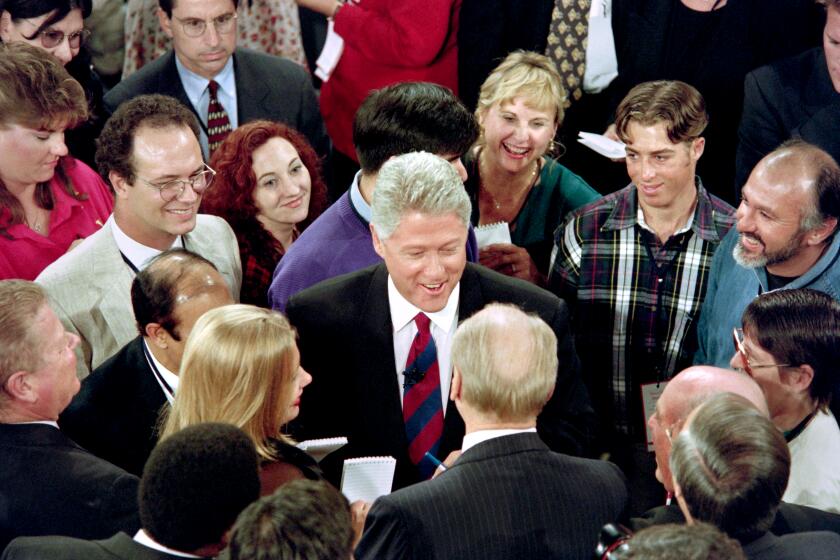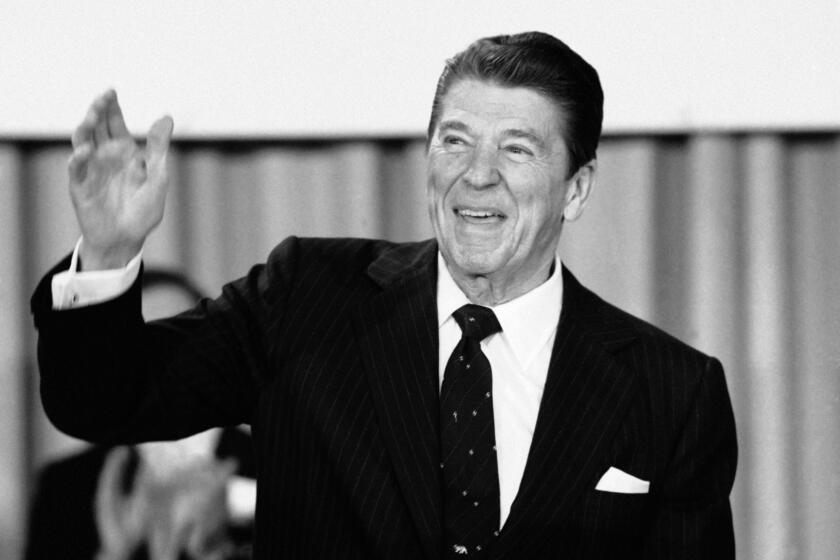Opinion: A lot of California Democrats loathed Gov. Ronald Reagan. Here’s why they’re misguided

In his first-ever bid for political office, former actor Ronald Reagan was elected governor of California in 1966, defeating two-term incumbent Gov. Pat Brown in a landslide. There was good reason for Democrats to fear that a radical right-winger had taken control of what even then was the nation’s most populous state.
The onetime New Deal Democrat had become a very conservative Republican who often echoed the conspiratorial complaints of the John Birch Society. He regularly warned that social welfare legislation such as Medicare and Medicaid (“socialized medicine” to Reagan) and civil rights laws were going to lead to the total extinction of freedom in America. In his famous 1964 “time for choosing” speech delivered on behalf of Republican presidential candidate Barry Goldwater, Reagan complained that Democratic leaders were “taking the party of Jefferson, Jackson and Cleveland down the road under the banners of Marx, Lenin and Stalin.”
Yet, once in Sacramento, Reagan upended radical expectations — as he would later do as president — by showing that he had a hidden streak of pragmatism. He governed much more moderately than he campaigned, and than most of today’s deep-blue Californians might believe. His pragmatism, not ideology, set him on the path to a historic presidency.
Through money and lavish attention, Bill Clinton colored California a lasting shade of blue, dramatically reshaping the nation’s presidential map in the process.
Start with Reagan’s very first budget, in 1967. It included the largest spending plan and the largest tax hike in the history of California — or any other state — up to that point.
Before he ran for governor, he campaigned against the Rumford Fair Housing Act, California legislation backed by Brown that prohibited discrimination in the sale or rental of housing. But when conservative legislators tried to repeal the act during Reagan’s term, he revealed a change of heart, after talking with Black leaders who explained to him how important it was.
Another issue on which Reagan changed his mind was tax withholding. He had initially opposed automatic deductions from paychecks on the grounds that “taxes should hurt.” But once his aides explained to him how much revenue the state was missing by not withholding tax payments, he came to support the deductions. The governor had previously said that his feet were set in concrete on the issue. When questioned about his change of heart, he replied, with a smile, “The sound you hear is the concrete cracking around my feet.”
The Heritage Foundation’s playbook for a second Trump presidency would revive many of Ronald Reagan’s worst policies.
When Reagan became governor, abortion in California was legal only if needed to save the mother’s life. Democratic State Sen. Anthony Beilenson (D-Woodland Hills) introduced a bill that would also allow abortions in the case of rape or incest or if the pregnancy threatened a woman’s physical or mental well-being. Reagan agonized about this legislation but ultimately signed it, thereby giving California one of the most liberal abortion laws in the country, six years ahead of Roe vs. Wade.
Reagan later expressed regret about signing the abortion bill, as he did about appointing Donald R. Wright as chief justice of the state Supreme Court after Wright voted to overturn the death penalty as unconstitutional. But that he made such moves in the first place shows Reagan’s relatively non-ideological approach to governance. In rejecting a fiscally conservative plan to reduce state grants to the disabled, for example, Reagan told his Sacramento Cabinet, “The politics in this doesn’t count — what’s right and wrong is the main thing. I always say it is right to do what we can for those who are really in need.”
The one area where Reagan was most ideological — and least successful — was in his approach to campus unrest. College campuses in California were in turmoil in the 1960s, with protests over the Vietnam War, racial discrimination and other causes. Reagan took a hard-line position that culminated in his dispatch of thousands of National Guard troops to UC Berkeley in 1969 to restore order after the People’s Park demonstrations, in which one bystander was killed by police and many others injured. During a 1969 strike at San Francisco State University by minority students demanding the creation of a Black studies department, Reagan said, “I say that this confrontation must be won, and I don’t care what force it takes.” Later, in 1970, when asked what it would take to restore order on campus, he snapped, “If it takes a bloodbath, let’s get it over with. No more appeasement.”
Ronald Reagan, the Hollywood actor who became one of the most popular presidents of the 20th century and transformed the political landscape of an era with his vision of conservative government, died Saturday at his home in the Bel-Air neighborhood of Los Angeles.
Reagan’s militaristic approach thrilled middle-class voters who were appalled by hippies on campus but only ratcheted up tensions and gave student radicals the clashes they sought with “the establishment.” The Los Angeles Times, which had endorsed Reagan, inveighed against the “overreaction by police and National Guardsmen” in Berkeley with their “indiscriminate use of tear gas and buckshot,” arguing that “they played into the hands of the revolutionaries by a use of repressive force beyond any order of magnitude required.” Democratic Assemblyman John Burton of San Francisco complained that Reagan had turned Berkeley into “his own Vietnam” and castigated him for trying to use “armed force” to solve “the great social problems of our time.”
But Reagan’s hard-line approach to campus unrest was a deviation in his mostly moderate two terms in Sacramento.
He worked with Democrats to pass welfare reform legislation that tightened up eligibility requirements while increasing benefits for 80% of recipients—a model of bipartisan compromise.
Despite his comment that “a tree is a tree, how many more do you need to look at?” — often remembered, wrongly, as “if you’ve seen one redwood, you’ve seen them all” — Reagan added 145,000 acres to the state’s parks. And, despite his attacks on colleges as hotbeds of lawlessness and licentiousness, he increased funding for the state’s universities by 136%. State spending, in fact, grew at nearly the same rate under Reagan as it had under Pat Brown.
There’s political idolatry, and then there’s the canonization in movie’s clothing that is Sean McNamara’s faith-tinged bio-epic “Reagan,” starring Dennis Quaid as the 40th president.
Some conservatives were disenchanted by Reagan; one Republican state senator griped in 1975, “When you come down to it, we have a hell of a lot more government in California than before Reagan came in.” But Reagan’s approval rating was high, and he had bipartisan support.
“I think he was a pretty good governor,” Jerry Brown, Reagan’s successor as governor (and son of the governor he defeated in 1966), told me. “I think in some ways he was a better governor than president.” Willie L. Brown, a powerful San Francisco Democrat and future Assembly speaker, who had first been elected to the State Assembly in 1964, agreed in an interview that he “ended up being a pretty good governor.”
Reagan’s election as president of the United States, nearly six years after leaving office in Sacramento, created fresh fears about a radical right “warmonger” taking power. Democrats would have breathed easier if they had examined his record as governor of California more closely. Reagan’s time in Sacramento taught him how to govern from the center and set him on the path toward becoming one of America’s most successful presidents. If only today’s Republican leaders were as pragmatic as Reagan; America would be far less divided and far better off.
Max Boot is a senior fellow at the Council on Foreign Relations and a Washington Post columnist. This article is adapted from “Reagan: His Life and Legend.”
More to Read
A cure for the common opinion
Get thought-provoking perspectives with our weekly newsletter.
You may occasionally receive promotional content from the Los Angeles Times.













